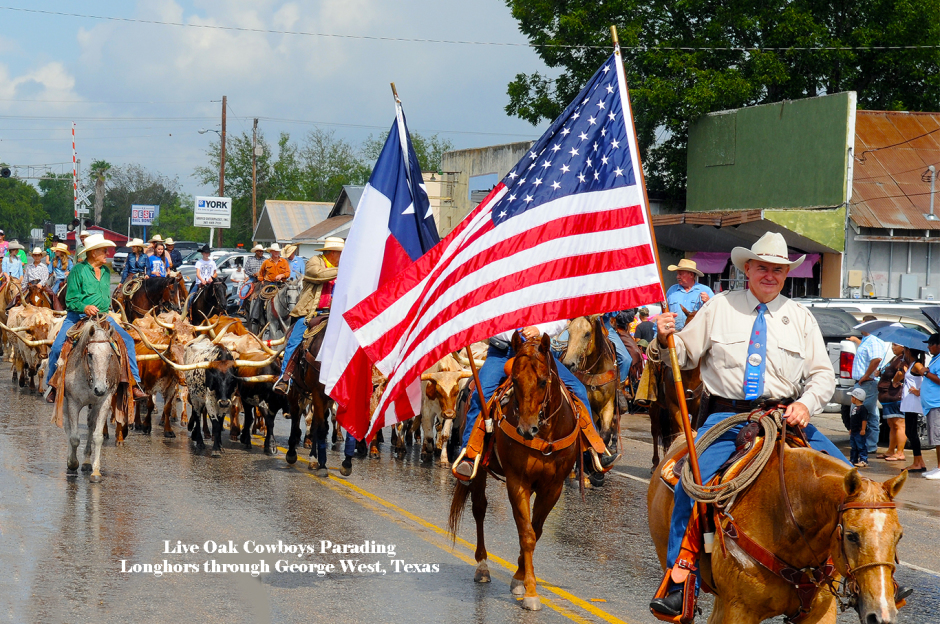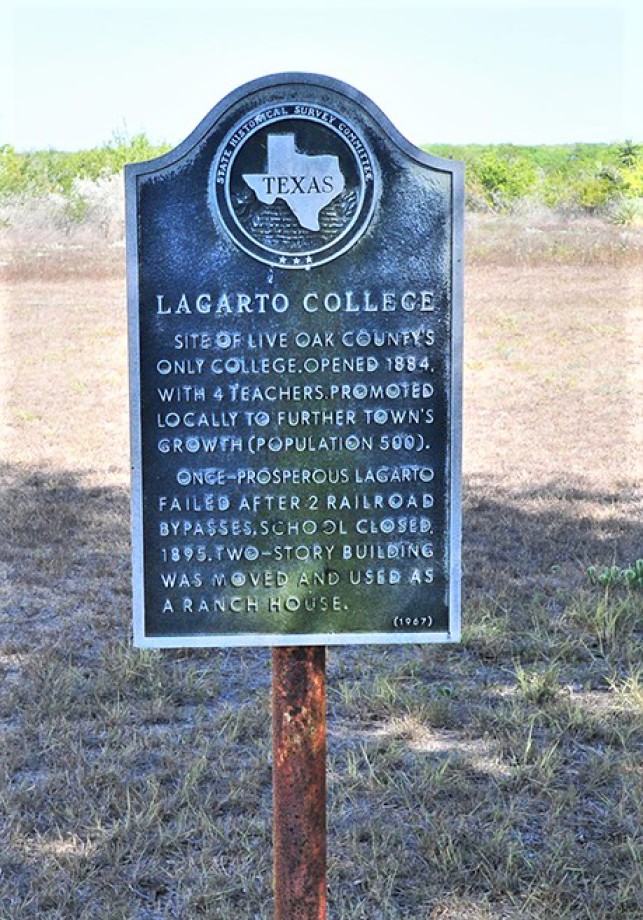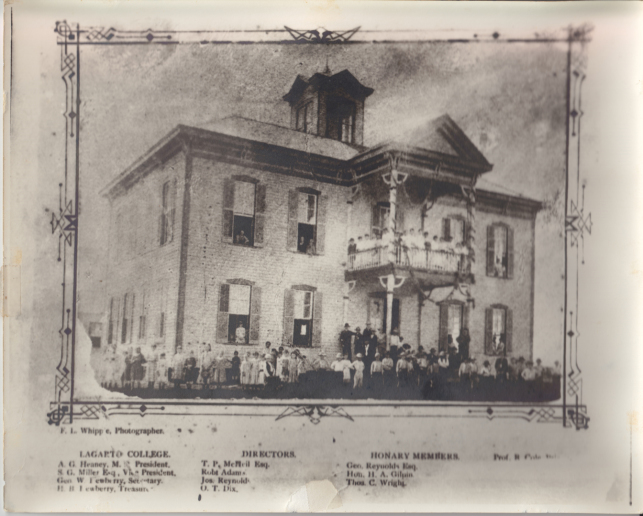
Lagarto College
Live OaK County Judge: Honorable Harry L. Hinton
Live Oak County Historical Commission and Marker Chair: S.T. Brown, Jr.
Lagarto College Application Narrative: Thelma Lindholm
Lagarto College Sponsor: Lagarto Community
Date Unveiled: 1967
Texas Subject Marker Text:
LAGARTO COLLEGE
SITE OF LIVE OAK COUNTY'S ONLY COLLEGE. OPENED 1884, WITH 4 TEACHERS. PROMOTED LOCALLY TO FURTHER TOWN'S GROWTH (POPULATION 500). ONCE-PROSPEROUS LAGARTO FAILED AFTER 2 RAILROAD BYPASSES. SCHOOL CLOSED, 1895. TWO-STORY BUILDING WAS MOVED AND USED AS A RANCH HOUSE. (1967) Marker is Property of State of Texas.
APPLICATION NARRATIVE and BIBLIOGRAPHY FOR OFFICIAL TEXAS HISTORICAL SUBJECT MARKER:
Lagarto College Application Narrative written by Thelma Lindholm
Lagarto College
Lagarto is found in the extreme southern part of Live Oak County; there you find the remains of a once flourishing town. This was a ranching community, but in 1856, John W. Ramey, a saddle tree maker laid out the town. The Plaza or Public Square was the center of the town. It was called, "Roughtown" by Calvin Wright, a store keeper.
The name, "Roughtown" may or may not have carried a significant meaning, but a saloon was the cause of some disturbances which the citizens did not appreciate. A collection was taken up, and the saloon keeper sold his building. He moved his trade and wares to greener fields; his building was given to a poor man for a home. This was concurrent with the opening of the Lagarto College.
Samuel Cook circulated a petition among the citizens of the Community; the petition requested the Texas Legislature to pass a law to prevent anyone else from opening a saloon, and prohibiting the sale of intoxicating liquors within two miles of the College. The request was granted.
Back to the name Lagarto; some think the name was coined by Mexicans; the near by creek harbored many alligators, and Mexicans called it El Lagarto or Lagartors. So, as the saloon passed on so was the name "Roughtown" forgotten.
The town of Lagarto is a ghost town with a population of less than a dozen citizens. It is situated on the Lagarto Creek in Live Oak County, on the west side and within a short distance of the Nueces River. When Lagarto is remembered today, it is through an attribute that was imposed upon it and that has cast a glamour over it through all of its years. To remember Lagarto is to remember it as a college town.
In the 1880's, when the town was at the peak of its population of not over 500 citizens - an ambition arose to further the growth of the town in an educational way. A project was set on foot to make a college town of Lagarto. In order to finance an adequate building, "The Lagarto College Company" was formed, with a capital stock of $6,000. Certificates of shares were issued at $10 a share. Dr. A.C. Heany, who had recently come to Lagarto from New York, was elected president, and George Newberry, secretary. The community and adjoining counties were canvassed and enough stock was sold to enable the company to erect a two-story, rather pretentious (for those days) building.
The college opened its doors the fall of 1884, with four teachers, one for each room. There were never more than four teachers at any one time.
Several of the ranch families from some distance sent their sons and daughters to board in town and attend the school-or college, as it was called.
So the dream of those pioneers who visualized Lagarto as a college town was fully realized, but in substance the "college" was as vaporous as their dream. If Lagarto, in reality, never reached the status of a college town, it gained a never-dying reputation of having been one. Today any "newcomer" interested in the back-ground of this locality will not be long in becoming acquainted with the legend that the ghost town of Lagarto was once the seat of a college. And old-timers will recall that at one time a college was there.
Mr. Freeman McWorther of Lagarto took a picture of the College to the Bee-Picayune, Beeville. The Bee-Picayune published an article about the College. "Mr. McWorther attended the College and enjoys many fond recollections of events connected with the school. T.J. Lyne, Tom Polland, Lee Moorman, and Hannah Polland, who later married Lee Moorman, were students there. Some of us are able to add, smugly, that we attended it-The Lagarto College." Mrs. R.J. Dobie, taught the first, second, third and fourth grades in 1885-86, when she was Miss Ella Byler. (Miss Ruth Dodson, in a letter to Thelma Lindholm, Dated 1956.)
Lagarto today has only a few buildings left of its once proud city of destiny. You can find the remains of a school house, a house where the teacher lived, a filling station, a store and a couple of other houses. It did have a post office, when Miss Zarapha Cook, retired after 37 years of service and the community was made a part of the the rural route. (Corpus Christi Caller, June 27, 1940. Library of Thelma Lindholm.)
Sterling N. Dobie, an uncle of J. Frank Dobie, well known Texas writer, built his home in this area. The lumber for this house was heived [sic-most likely heaved meaning cut with an ax] from trees which grew along the Lagarto Creek. The building still stands and is used as a barn on the McWorther Ranch.
Miss Minnie Alexander, who celebrated her 83rd. birthday in 1940, told that she buried two jars of gold and silver for Dobie, her [grand] father, close by the old cistern; and, so far as she knows, it has never been found. (Told by Miss Alexander to Thelma Lindholm at her [Minnie Alexander] 83rd Birthday Celebration.)
J. Frank Dobie was born in another house a few miles away which is almost completely dilapidated.
We pause to wonder-Where have the people gone? Why did the College close after eleven years? Why was the building sold and converted into a Ranch Home? Why a ghost town filled with Historical memories? One answer to the questions, "Two railroads failed to go through Lagarto." [Note on the sideline remarks, "closed after 11 years ... That would have been in the spring of 1895.]
Just when the first idea of a railroad was conceived is not known, but as early as September 29, 1881, hopes for the coming of the Texas-Mexican Railroad had begun to fade. (The Lagarto News, September 29, 1881. Library of Thelma Lindholm.)
The winds fanned the sparks again; From the Corpus Christi Leader, November 19, 1881:
"We learn that contractors Lott and Nelson had a carload of camping outfit burned a few days ago near Benevidas. The fire was caused from cinders from the locomotive. If these gentlemen receive orders to commence work on the branch line of the road from San Diego through our town, Lagarto, their recent loss may cause some delay." (Corpus Christi Leader, November 10, 1881, p.4. Library of Thelma Lindholm.)
Lagarto lived through several of these railroad phases; their real estate advanced 100%. Like the corn and the calves that grew in the night, while they were asleep, every man felt the railroad was certain to come through Lagarto and that he was getting rich. The blow came in 1888. The San Antonio and Aransas Pass Railroad ran a branch line south to intersect the Texas-Mexican Railroad which runs from Corpus Christi to Laredo. It failed to pass through Lagarto; this was the beginning of the undoing of the little town.
The greater number of the citizens moved to points on the railroad. Then a one-teacher school was enough for the reduced population. The College building, after standing vacant for some time, was sold to a rancher who moved it away and made a dwelling of it.
The Lagarto News closes this period in this way: "In Lagarto the railroad subject first blows hot then blows cold; one day their hopes are in the clouds, the next day down in the dust. And when Mr. Taylor appears on the scene again and kicks the whole pyrimid [sic] of their expectations over by saying, 'I don't want any more right-of-way; the road is gone up.' They dug a hole six feet deep, rolled it all in and shoveled the dirt in over it." (Lagarto News, Lagarto, February 10, 1896. Library of Thelma Lindholm.)
The long sought railroad became a reality for Live Oak County in 1912, but it doomed the town of Lagarto. The S.A.U. and G. Railroad by-passed every early town and settlement of Live Oak County, thereby closing that era and opening an entirely new era of town and county development.
Lagarto was included in this new era of development when man's needs of water caused the first dam to be built on the Nueces River in the Mathis-Sandia area in 1927. This dam defied the waters of the Nueces River for only a short time. At the first big rise of the River, the dam silently but surely fell to the power of the Nueces River.
A larger and stronger dam was built in 1929, and Lake Corpus Christi became a reality. This dam was raised higher in 1958 and was dedicated as the Wesley Seals Dam, most people think of it as the Mathis Dam, from its location. The lake soon reached a water level of 94 feet.
Lagarto lost her bridge across the Nueces River to this Lake, but she gained one of the most beautiful Lake fronts in the State of Texas. On this Lake Front, there are seven divisions of housing developments, with an approximate total of 700 homes. Some of these homes are occupied the year around, some are occupied on the weekends or through the summer, but the estimated population is around 1400 people.
So, there are people who wander into and through the remains of the once flourishing town. They stand and try to imagine how it looked in the days as the "College Town." (H.L. Hinton, Live Oak County Judge, December 14, 1966.)
Thanks to Lynette Chen, Sarah McClesky, and Bob Brinkman, Director at the THC Marker Archives in Austin for sharing this narrative and folder information.
[Note to viewers: "College" in the 1800's did not always mean what it means today. As noted above, Ella Jane Byler's class was 1st through the 4th grades in the traditional sense. The big difference in the "College" and other community schools was that special subjects like music and literature were taught by teachers dedicated to those subjects, and the curriculum was more classic than traditional. Families had to pay considerably more for their children to attend this school than to attend a County School. One story from Lagarto College is that Samuel Beall, while a student there, was awarded a Stradivarius violin by his music teacher for Sam's outstanding develpment of his talent for playing the violin.]


